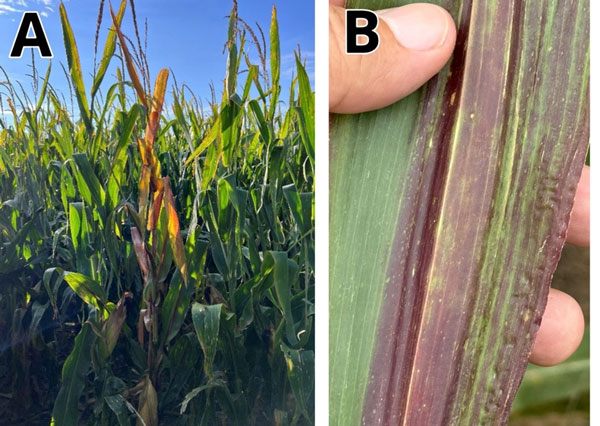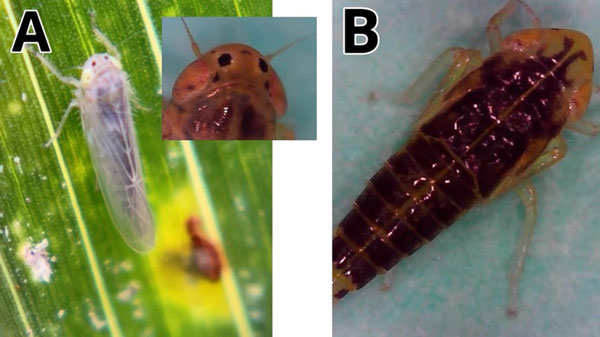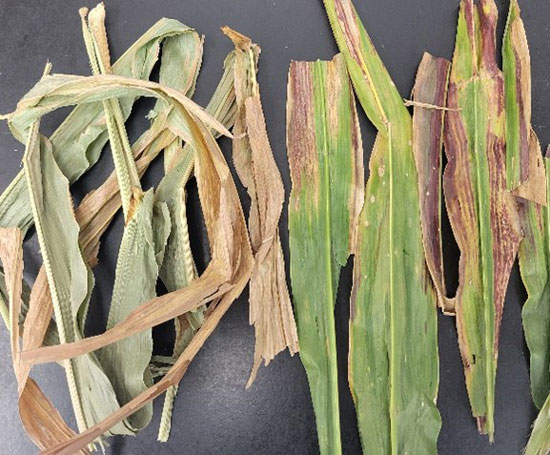Corn stunt disease and its associated vector, the corn leafhopper (Dalbulus maidis), have been recently confirmed in Kansas. To our knowledge, this is the first detection of the disease in Kansas, and it came shortly after the disease was first reported in Oklahoma and Missouri. Corn stunt disease and associated symptoms have been confirmed in Sedgewick, Pratt, Stafford, and Edwards Counties in field corn and Riley County in sweet corn (Figure 1). Recent scouting efforts across Kansas confirm active leaf hoppers in many additional counties in Central and Southwest Kansas. Disease incidence was low overall, and most corn is reaching later stages of maturity.

Figure 1. Corn stunt disease distribution in Kansas in 2024 as of August 29, 2024. Yellow represents counties from which laboratory testing confirmed positive samples and may not reflect complete distribution in the state.
Symptoms of the disease may include shortened internodes, which can result in a stunted stature of the corn plant, as well as leaves with red discoloration (Figure 2). Because other biotic and abiotic factors can cause red or purple discoloration in corn, laboratory testing is important to diagnose corn stunt disease and distinguish it from other stressors.
In the past, corn stunt disease has been limited in distribution to southern Texas, Florida, and California in the United States. Corn stunt is caused by a wall-less bacterial pathogen called corn stunt spiroplasma (CSS, Spiroplasma kunkelii). The corn leafhopper can also transmit additional pathogens, either singly or in combination with the corn stunt spiroplasma. To date, only corn stunt spiroplasma has been detected in Kansas. Additional research is needed to determine the presence of other pathogens vectored by the corn leafhopper in Kansas.

Figure 2. Symptomatic corn plant and a close-up of a leaf showing red discoloration and streaking. Photo courtesy of Rodrigo Onofre, K-State Research and Extension.
This disease is spread only by the corn leafhopper (Dalbulus maidis) (Figure 3), which was also just confirmed in Kansas. The corn leafhopper acquires pathogens within minutes of feeding on infected corn plants, but it can take up to 30 days for the leafhopper to infect healthy corn plants during feeding events.

Figure 3. Images of a corn leafhopper A) adult on a corn leaf and magnified view of the two, black spots between the eyes; and B) nymph showing dark brown coloration and developing wing pads. Photo courtesy of Brian McCornack, K-State Research and Extension.
The corn leafhopper is relatively simple to identify under magnification. These leafhoppers are light tan to yellowish-white in color and approximately 1/8” long. Two distinct dark spots between the antennae and eyes are very characteristic of this species. Nymphs lack wings and can vary in color. Like most leafhoppers, all stages move quickly when disturbed and hide in shaded areas of corn plants. All stages can be sampled using a sweep net; a video showing how to sample for corn leafhoppers in mature corn canopies can be found here: https://tinyurl.com/KSUCLH. You can also view the video by scanning the QR code below.

If you suspect a field has corn stunt, submit a sample to the K-State Plant Disease Diagnostic Lab. The best type of sample for corn stunt testing is living symptomatic leaf tissue (Figure 4- right side). Dry/senesced corn leaves are not recommended (Figure 4 – left side) and may lead to inconclusive results. Entire plants are not required to test for this disease, as only the midrib will be used in testing.

Figure 4. Poor dry/senesced corn leaves (left) and LIVING symptomatic corn leaves (right).
Collection and shipping instructions can be found below:
- Collect and ship samples on or before Wednesday to avoid weekend storage
- Collect symptomatic living leaves (ideally from multiple symptomatic plants)
- Label and use plastic bags; Do not use paper bags, and do not add water.
- Fill out the submission form. Include variety/hybrid info.
- Ship leaves ASAP overnight via UPS or FedEx when possible. USPS can take up to 14 days
- Send photos to clinic@ksu.edu with tracking number or date shipped
- Three types of images to send:
- Symptom/problem close up and in focus
- Three types of images to send:
-
-
- Entire plant from ground level to the top of plant
- Site – capture the pattern in the field, transition areas, terraces, etc.
-
Rodrigo Onofre, Row Crop Plant Pathologist, Department of Plant Pathology
onofre@ksu.edu
Brian McCornack, Professor and Department Head, Department of Entomology
mccornac@ksu.edu
Anthony Zukoff, Extension Associate, Department of Entomology
azukoff@ksu.edu
Chandler Day, Associate Diagnostician, Department of Plant Pathology
clinic@ksu.edu
Tags: corn disease corn stunt corn leafhopper